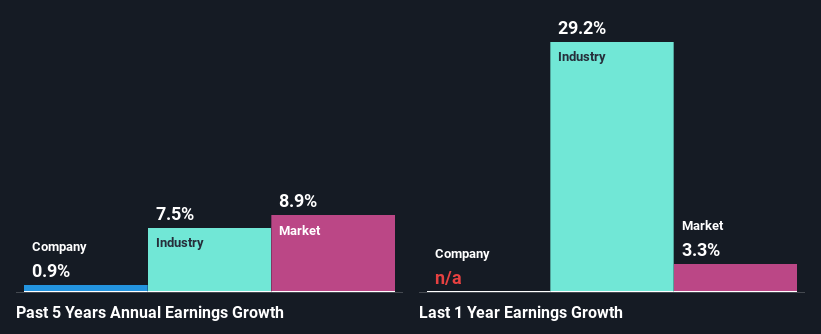Weak Financial Prospects Seem To Be Dragging Down Totally plc (LON:TLY) Stock
With its stock down 11% over the past month, it is easy to disregard Totally (LON:TLY). Given that stock prices are usually driven by a company’s fundamentals over the long term, which in this case look pretty weak, we decided to study the company's key financial indicators. Particularly, we will be paying attention to Totally's ROE today.
ROE or return on equity is a useful tool to assess how effectively a company can generate returns on the investment it received from its shareholders. Simply put, it is used to assess the profitability of a company in relation to its equity capital.
View our latest analysis for Totally
How Do You Calculate Return On Equity?
The formula for ROE is:
Return on Equity = Net Profit (from continuing operations) ÷ Shareholders' Equity
So, based on the above formula, the ROE for Totally is:
0.9% = UK£318k ÷ UK£34m (Based on the trailing twelve months to March 2021).
The 'return' is the profit over the last twelve months. That means that for every £1 worth of shareholders' equity, the company generated £0.01 in profit.
Why Is ROE Important For Earnings Growth?
We have already established that ROE serves as an efficient profit-generating gauge for a company's future earnings. Depending on how much of these profits the company reinvests or "retains", and how effectively it does so, we are then able to assess a company’s earnings growth potential. Assuming all else is equal, companies that have both a higher return on equity and higher profit retention are usually the ones that have a higher growth rate when compared to companies that don't have the same features.
A Side By Side comparison of Totally's Earnings Growth And 0.9% ROE
As you can see, Totally's ROE looks pretty weak. Even when compared to the industry average of 6.4%, the ROE figure is pretty disappointing. As a result, Totally's flat earnings over the past five years doesn't come as a surprise given its lower ROE.
As a next step, we compared Totally's net income growth with the industry and were disappointed to see that the company's growth is lower than the industry average growth of 7.5% in the same period.
Earnings growth is an important metric to consider when valuing a stock. What investors need to determine next is if the expected earnings growth, or the lack of it, is already built into the share price. This then helps them determine if the stock is placed for a bright or bleak future. What is TLY worth today? The intrinsic value infographic in our free research report helps visualize whether TLY is currently mispriced by the market.
Is Totally Efficiently Re-investing Its Profits?
Totally has a very high LTM (or last twelve month) payout ratio of 287% over the last last three years, which suggests that the company is dipping into more than just its earnings to pay its dividend. The absence of growth in Totally's earnings therefore, doesn't come as a surprise. Paying a dividend higher than reported profits is not a sustainable move. This is quite a risky position to be in. Our risks dashboard should have the 2 risks we have identified for Totally.
Only recently, Totally started paying a dividend. This means that the management might have concluded that its shareholders prefer dividends over earnings growth. Our latest analyst data shows that the future payout ratio of the company is expected to drop to 23% over the next three years. As a result, the expected drop in Totally's payout ratio explains the anticipated rise in the company's future ROE to 13%, over the same period.
Summary
In total, we would have a hard think before deciding on any investment action concerning Totally. Specifically, it has shown quite an unsatisfactory performance as far as earnings growth is concerned, and a poor ROE and an equally poor rate of reinvestment seem to be the reason behind this inadequate performance. With that said, the latest industry analyst forecasts reveal that the company's earnings are expected to accelerate. Are these analysts expectations based on the broad expectations for the industry, or on the company's fundamentals? Click here to be taken to our analyst's forecasts page for the company.
This article by Simply Wall St is general in nature. It does not constitute a recommendation to buy or sell any stock, and does not take account of your objectives, or your financial situation. We aim to bring you long-term focused analysis driven by fundamental data. Note that our analysis may not factor in the latest price-sensitive company announcements or qualitative material. Simply Wall St has no position in any stocks mentioned.
Have feedback on this article? Concerned about the content? Get in touch with us directly. Alternatively, email editorial-team (at) simplywallst.com.

 Yahoo Finance
Yahoo Finance 
